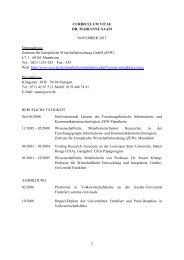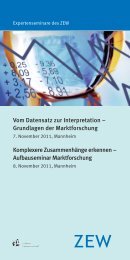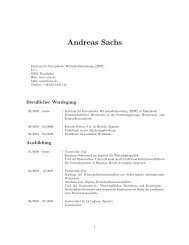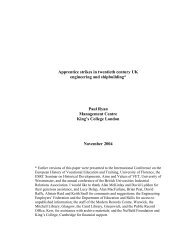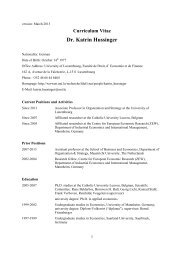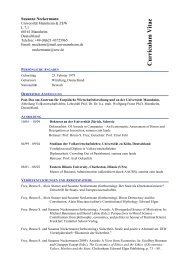Does Alma Mater matter? Evidence from Italy*
Does Alma Mater matter? Evidence from Italy*
Does Alma Mater matter? Evidence from Italy*
Create successful ePaper yourself
Turn your PDF publications into a flip-book with our unique Google optimized e-Paper software.
Assuming that the uncovered effects are at least in part permanent, they<br />
suggest that policies favouring the diffusion of universities in the Italian<br />
territory need not be farsighted, as employment probabilities are significantly<br />
higher with larger – and older - institutions, possibly because of their<br />
entrenched reputation in the labour market. Policies promoting equal<br />
opportunity and a higher percentage of female professors have ambiguous<br />
labour market effects, negative on male graduates and positive on female<br />
graduates. Finally, and conditional on measured quality and on local labour<br />
market effects, Southern universities perform less satisfactorily than the<br />
universities in the rest of the country. Understanding why this is the case is an<br />
important area of policy evaluation.<br />
The paper is organized as follows. Section 1 provides some institutional<br />
background; Section 2 discusses the empirical approach; Section 3 introduces<br />
the data and Section 4 presents the results. Conclusions follow.<br />
1. Institutional background<br />
By international standards, Italy has 10 graduates out of 100 individuals<br />
aged 25 to 64, significantly lower than the OECD average of 15. Relatively low<br />
attainment is matched by a relatively low rate of return, 6.5 percent per year<br />
of college education, compared to 11.8 percent in the main developed<br />
economies (see OECD, 2003). Assuming a downward sloping demand for<br />
college education and an upward sloping supply, the combination of low<br />
attainment and low returns suggests that the relative demand for college<br />
graduates in Italy is relatively low by international standards 1 .<br />
Reasons for relative low demand could be that the Italian industrial<br />
structure is biased against higher education, or that the perceived quality of<br />
tertiary education is low, or both. According to the OECD, Italy spends less<br />
than the major developed economies for tertiary education. In the year 2000,<br />
the average expenditure per student was 8065 US dollars, compared to 8373<br />
dollars in France, 10898 dollars in Germany, 9657 dollars in the UK and 20358<br />
dollars in the US. Low expenditure is partly due to the fact that average pay in<br />
1 See Brunello, Comi and Lucifora, 1999, and Checchi and Jappelli, 2004, and Checchi, 2002.<br />
3




